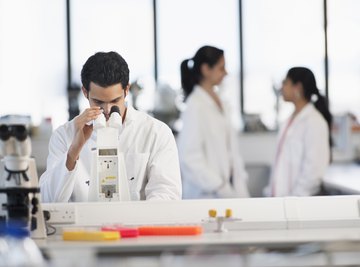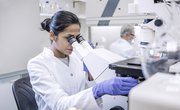
The endoplasmic reticulum (ER) is a membrane-bound cell organelle whose membrane is folded into flat compartments. The rough endoplasmic reticulum (RER) is a specialized area in which ribosomes are attached to the surface folds, giving the ER a rough appearance.
The presence of the ribosomes provides the RER with a special and additional capability to process specific proteins needed by the cell. Cells that produce a lot of proteins have large numbers of ribosomes on the RER.
The ER membrane is a continuation of the outer membrane of the nucleus. The ER membrane connects different tubules, or compartments, and the nucleus itself. The rough ER is a protein factory.
Where the RER and its ribosomes specialize in the synthesis and processing of proteins, the rest of the ER, called the smooth endoplasmic reticulum (SER, which does not have attached ribosomes), produces lipids and other chemicals needed by the body, by the tissues in which the cells are located and by the overall organism.
The Structure of the ER Is Ideal for Chemical Synthesis
One way of visualizing the ER is as a series of flattened, enclosed compartments connected by small openings. An opening at one end is attached to the outer nuclear membrane. The flattened folds give the ER a large surface area on which to carry out its chemical synthesis activities, and the interconnection of compartments allows the produced chemicals to flow freely to where they will be used, processed or exported.
The flattened compartments of the endoplasmic reticulum are called cisternae, and they are all completely enclosed by the single, heavily folded outer membrane. Inside each compartment is the cisternal space, and the ribosomes are attached on the outside of the membrane of the RER.
Because the compartments are all segments inside the single membrane, they are interconnected. Chemicals that are synthesized in one compartment can flow throughout the ER and back to the nucleus. When the ribosomes produce proteins, the proteins can pass through the ER membrane into one of the compartments and migrate to where they are needed.
The Endoplasmic Reticulum Function Is That of a Chemical Factory
Like a factory, the ER manufactures and processes the chemicals needed by the cell. Its large surface area provides room for the chemical reactions, and the folds that extend into remote areas of the cell make it an ideal pathway for distributing proteins and lipids.
It gets its instructions through the messenger ribonucleic acid (mRNA) from the nucleus acting on the ribosomes. If it produces extra chemicals, it can store them in the cisternae until they are needed.
The ER factory has different sections. The smooth ER works to synthesize its chemicals on the ER membrane itself while the rough ER function is to process the required proteins.
The RER has the ribosomes that each operate as miniature assembly lines for their products. Membrane chemicals act as loading docks to allow the ribosome proteins into the ER. Other mechanisms accept the chemicals produced by the ER and handle distribution to other parts of the cell.
Some of the factory's products are used by the ER itself for growth and repair or to manufacture more ribosomes in the nucleus. Other chemicals are sent out to the cell to use for cell growth, cell division and repair of the cell membranes. Still other chemicals are needed by other parts of the body, and the cell's ER sends them out to be secreted by the cell into the surrounding tissue or into the circulatory system.
The ER Factory Has Complicated Operations
Like any factory, the ER makes some products itself and has others delivered. Some ribosomes remain attached to the RER while others are free-floating in the cell and only attach to the ER when they produce RER proteins. The building blocks for the chemical product and the required energy have to be available, and the final product has to be shipped out.
Typical steps for proper rough ER function include the following:
- Gene designation: The cell decides what protein is needed and designates the corresponding genes of the cell DNA for copying.
- Gene transcription: The designated genes are transcribed onto mRNA molecules.
- Instruction delivery: The mRNA molecules exit the nucleus and find ribosomes that can produce the needed protein.
- Chemical production: The ribosomes attach to the RER and use raw materials from the cell cytosol to produce a protein according to the coded instructions.
- Chemical delivery: As the ribosome synthesizes the protein, it is transferred into the ER cisternae and is sent to where it is needed.
When the ribosomes receive their instructions from the mRNA, they take up their position on the outside surface of the RER and send the produced protein into the RER to be stored, delivered or used.
Transcribing and Delivering the Genetic Code
The deoxyribonucleic acid (DNA) that holds the original genetic code can't leave the nucleus and is contained inside the inner nuclear membrane. The mRNA copies the genes needed for production of specific chemicals. It can exit the nucleus through special pores in the inner nuclear membrane and can then enter the cell cytosol to deliver the required instructions.
If the instructions are for an RER protein, the mRNA binds to a ribosome. The ribosome follows the instructions and attaches to the RER.
The cell's DNA is a double stranded helix of nucleic acids. The mRNA molecule is assembled according to the amino acid sequence in one of the two strands. When the mRNA reaches the ribosome, the mRNA instructions allow the re-creation of the amino acid sequence of the DNA.
The ribosome can take amino acid building blocks from the cell cytosol and assemble them in the correct sequence to form complex proteins.
The Ribosomes Build the Required Proteins
Ribosomes themselves are made up of ribosomal RNA and special ribosomal proteins. One segment of the ribosome reads the mRNA instructions, and a second segment builds the protein chains accordingly.
Membrane-bound ribosomes are engaged in synthesizing proteins designated for the ER and are funneling their product straight through the RER membrane into the RER cisternae. Ribosomes that manufacture non-RER proteins can remain free-floating and release their proteins into the cell cytosol.
When a free-floating ribosome starts to produce a protein meant for the RER, it attaches itself to a special RER site called a translocon. The RER proteins contain a targeting signal to let the ribosome know where to go.
A special protein sequence tells the ribosome that the protein it is synthesizing is meant for the endoplasmic reticulum. It attaches itself to a translocon, produces the required amount of protein and then either detaches and starts making other proteins or stays attached but inactive.
The RER Processes and Stores the Proteins Synthesized by the Ribosomes
When the ribosomes join the RER protein factory and act as miniature assembly lines, the products coming off the lines are not yet ready for use. The ribosomes attached themselves to the translocon and synthesized the proteins for the RER because of the special signaling sequence that the proteins contained. The RER removes the signaling sequence from the proteins and folds them so they can be stored or shipped as needed.
The ER needs some of the produced proteins for its own use. The ER membrane has to be repaired and maintained, and the cell may be growing and need more ER material.
To keep a protein that it needs, the ER attaches a new signaling sequence designating the protein as one that will stay inside the cisternae. These are called endoplasmic reticulum resident proteins, and they support the endoplasmic reticulum function.
The ER Distributes the Synthesized Proteins as Needed
Proteins not needed by the ER itself are kept in the cisternae until they are sent to one of three places:
- The nucleus: The ER outer membrane continues as the nucleus outer membrane. This means there is a tight and continuous link allowing ER proteins easy access to the nucleus.
- Outside the cell: Cells with active ER protein synthesis often secrete substances for use outside the cell.
- Within the cell: The cell itself needs some proteins for growth and repair.
The nucleus needs a lot of different kinds of proteins for DNA copying, membrane maintenance, cell division and ribosome creation. It has easy and rapid access to these proteins through the link to the ER.
The ER proteins are present within the common ER/nucleus outer membrane but outside the inner nuclear membrane. Selected proteins can enter the nucleus through special pores in the inner membrane as the nucleus needs them.
While the nucleus has direct access to ER proteins due the the outer membrane link, the rest of the cell and the tissues outside the cell need a transport mechanism to deliver ER chemicals. If the ER released its chemicals into the cytosol, they would react with other substances such as oxygen and lose their effectiveness.
Instead, the ER sends its chemicals to the rest of the cell and other tissues in special containers.
Vesicles Distribute ER Substances to Where They Are Needed
The ER has developed a method of ensuring that chemicals processed and stored in the ER arrive unchanged at their destination. A common target for these chemicals is the Golgi apparatus, located near the ER in the cell cytoplasm. The Golgi apparatus takes in ER chemicals and further processes them, adding signal sequences that identify the targets and locations where the chemicals are needed.
This distribution of chemicals takes place inside vesicles formed by the ER and the Golgi apparatus.
For example, after a protein is synthesized by a ribosome attached to the RER, it is further processed in the ER and then migrates to the smooth endoplasmic reticulum. The smooth ER forms a pocket with its membrane, places the protein inside and detaches the package from the ER as an independent, fully enclosed vesicle.
The vesicle typically travels to the Golgi apparatus where the protein receives a tag with its target. If the protein is needed within the cell, the vesicle delivers it to another organelle such as the mitochondria or a lysosome. The vesicle can join the organelle's outer membrane and release the protein inside the organelle.
If the protein is needed outside the cell, the vesicle travels to the outer cell membrane, joins the membrane and releases the protein outside. The effect is that the cell secretes the protein into the surrounding tissue.
Only Primitive Cells Can Survive Without an Endoplasmic Reticulum
While some specialized cells such as blood cells have neither a nucleus nor an ER, most cells in complex organisms need the ER to handle the RER protein processing and the smooth ER lipid synthesis that are essential to cell survival.
Prokaryotic cells, such as bacteria, don't have an ER, but they function on a much simpler level, with chemicals being synthesized and released in the general cell cytoplasm. Eukaryotic cells, such as those found in animals, require the complex functionality of the ER to carry out their specialized operations.
References
About the Author
Bert Markgraf is a freelance writer with a strong science and engineering background. He has written for scientific publications such as the HVDC Newsletter and the Energy and Automation Journal. Online he has written extensively on science-related topics in math, physics, chemistry and biology and has been published on sites such as Digital Landing and Reference.com He holds a Bachelor of Science degree from McGill University.
